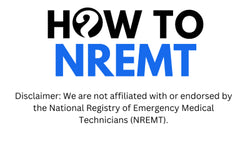No More Pre-Test Jitters – Pass California EMT Test with Confidence
Obtaining EMT certification in California can seem overwhelming. With various training programs, examinations, and state documentation, it can be quite a lot to manage. However, the reality is that if you succeed in the NREMT cognitive exam, you’re already significantly along the way.
That’s where How To NREMT steps in.
Our platform assists candidates in their preparation for the National Registry exam by offering strategy-focused, smart tools. Featuring practice tests that replicate the NREMT scoring system, AI tutors that provide instant assistance, and a 10-step complete training plan tailored for first-time test-takers, you can confidently proceed without any doubts about your next action.
Let’s break down what you need to do in California and how we can help you get there.
Step 01

Requirements to Become an EMT in California
In order to become an EMT in California, you must check off the following boxes:
- Meet the minimum age limit of 18 years
- Meet the minimum education requirement of a high school diploma or equivalent
- Enroll and complete a state-approved EMT course
- Pass the NREMT cognitive exam
- Pass the state psychomotor exam
- Meet basic background checks
Step 02

Take a California-Approved EMT Training Course
The State of California requires candidates to enroll in and successfully complete an EMT course approved by the Local EMSA (Local EMS Agency). The program blends lab, classroom, and clinical/field experience. After successful completion, the course director verifies your training, allowing you to become ready for the NREMT cognitive exam.
Start your NREMT cognitive exam practice with How To NREMT now.
Step 03

Prepare For and Pass the NREMT Cognitive Exam
The NREMT cognitive exam is a computer-adaptive test (CAT) in California, like the rest of the 50 states. You’ll take the exam at a Pearson VUE center. The difficulty of each question adapts to your answer to the preceding question.
The National Registry has updated its course domain for EMTs, keeping in mind current patient care and needs. The updated categories have replaced the traditional airway and cardiology domains.
All the candidates preparing for the NREMT cognitive exam after April 2025 must master the following categories:
- Scene Size-Up and Safety: This domain involves assessing the scene for life threats and hazards to the patient’s safety.
- Primary Assessment: This domain covers initial patient assessment, including their consciousness level, circulation, airway, and breathing.
- Secondary Assessment: This domain focuses on a more thorough patient assessment to obtain their medical history, run a physical exam, and recognize any underlying conditions.
- Patient Treatment and Transport: This domain involves patient interventions to ensure they’re transported safely after splinting fractures and administering oxygen.
- Operations: This domain focuses on EMS operations like ambulance stock maintenance and communication with dispatch.
Note: Items related to pediatric patient care are integrated throughout all domains.
In order to pass, candidates must rely on more than just rote memorization. You’re expected to apply your knowledge in real time. Keeping that in mind, How To NREMT has built a system that mirrors the real thing.
- Our 2000+ practice questions replicate the National Registry’s scoring algorithm
- Real-time feedback system lets you identify strong and weak areas
- AI-bot offers one-on-one online support whenever you feel stuck
How To NREMT’s 10-step training program is your route to passing the NREMT cognitive exam, regardless of whether it’s your first attempt or fifth.
Step 04

Apply for California State Certification
After preparing for and passing the NREMT cognitive exam with How To NREMT, you can apply for your EMT license through Local EMSA. Here’s what you need to do:
Go to your local EMSA portal and submit the following documents:
- Proof of state-approved EMT course completion
- NREMT exam passing result
- Psychomotor skills verification form
- CPR certification
- Fingerprint background check
Wait for the approval and EMT license.
Note: In California, each county has its local EMS office. Make sure you’re submitting documents to your respective county.
NREMT vs. California EMT Requirements: Key Differences
| Requirement | NREMT (National) | California (State) |
|---|---|---|
| EMT Course | Required | Required |
| NREMT Cognitive Exam | Required | Required |
| Skills Verification (ALS Psychomotor Skills) | Not required | State required |
| CPR Certification | Required | Required |
| Background Check | Not required | Required |
Note: The National Registry no longer tests for ALS psychomotor skills as of 2022. The skills requirements are only state-based.

- Choosing a selection results in a full page refresh.

